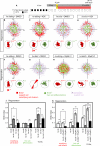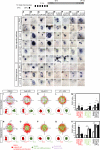Regeneration of Sensory Hair Cells Requires Localized Interactions between the Notch and Wnt Pathways
- PMID: 26190147
- PMCID: PMC4557215
- DOI: 10.1016/j.devcel.2015.05.025
Regeneration of Sensory Hair Cells Requires Localized Interactions between the Notch and Wnt Pathways
Abstract
In vertebrates, mechano-electrical transduction of sound is accomplished by sensory hair cells. Whereas mammalian hair cells are not replaced when lost, in fish they constantly renew and regenerate after injury. In vivo tracking and cell fate analyses of all dividing cells during lateral line hair cell regeneration revealed that support and hair cell progenitors localize to distinct tissue compartments. Importantly, we find that the balance between self-renewal and differentiation in these compartments is controlled by spatially restricted Notch signaling and its inhibition of Wnt-induced proliferation. The ability to simultaneously study and manipulate individual cell behaviors and multiple pathways in vivo transforms the lateral line into a powerful paradigm to mechanistically dissect sensory organ regeneration. The striking similarities to other vertebrate stem cell compartments uniquely place zebrafish to help elucidate why mammals possess such low capacity to regenerate hair cells.
Copyright © 2015 Elsevier Inc. All rights reserved.
Figures








Similar articles
-
Role of Wnt and Notch signaling in regulating hair cell regeneration in the cochlea.Front Med. 2016 Sep;10(3):237-49. doi: 10.1007/s11684-016-0464-9. Epub 2016 Sep 7. Front Med. 2016. PMID: 27527363 Review.
-
Insights into sensory hair cell regeneration from the zebrafish lateral line.Curr Opin Genet Dev. 2016 Oct;40:32-40. doi: 10.1016/j.gde.2016.05.012. Epub 2016 Jun 5. Curr Opin Genet Dev. 2016. PMID: 27266973 Review.
-
Gene-expression analysis of hair cell regeneration in the zebrafish lateral line.Proc Natl Acad Sci U S A. 2014 Apr 8;111(14):E1383-92. doi: 10.1073/pnas.1402898111. Epub 2014 Mar 27. Proc Natl Acad Sci U S A. 2014. PMID: 24706903 Free PMC article.
-
The role of Wnt/β-catenin signaling in proliferation and regeneration of the developing basilar papilla and lateral line.Dev Neurobiol. 2014 Apr;74(4):438-56. doi: 10.1002/dneu.22134. Epub 2013 Nov 15. Dev Neurobiol. 2014. PMID: 24115534
-
The stat3/socs3a pathway is a key regulator of hair cell regeneration in zebrafish. [corrected].J Neurosci. 2012 Aug 1;32(31):10662-73. doi: 10.1523/JNEUROSCI.5785-10.2012. J Neurosci. 2012. PMID: 22855815 Free PMC article.
Cited by
-
foxg1a is required for hair cell development and regeneration in the zebrafish lateral line.Biol Open. 2024 Sep 15;13(9):bio060580. doi: 10.1242/bio.060580. Epub 2024 Sep 20. Biol Open. 2024. PMID: 39301848 Free PMC article.
-
prdm1a drives a fate switch between hair cells of different mechanosensory organs.bioRxiv [Preprint]. 2025 Jun 3:2025.06.01.657251. doi: 10.1101/2025.06.01.657251. bioRxiv. 2025. PMID: 40501783 Free PMC article. Preprint.
-
Kremen1 regulates the regenerative capacity of support cells and mechanosensory hair cells in the zebrafish lateral line.iScience. 2023 Dec 7;27(1):108678. doi: 10.1016/j.isci.2023.108678. eCollection 2024 Jan 19. iScience. 2023. PMID: 38205258 Free PMC article.
-
Activity regulates a cell type-specific mitochondrial phenotype in zebrafish lateral line hair cells.Elife. 2023 Mar 13;12:e80468. doi: 10.7554/eLife.80468. Elife. 2023. PMID: 36912880 Free PMC article.
-
Saccular Transcriptome Profiles of the Seasonal Breeding Plainfin Midshipman Fish (Porichthys notatus), a Teleost with Divergent Sexual Phenotypes.PLoS One. 2015 Nov 11;10(11):e0142814. doi: 10.1371/journal.pone.0142814. eCollection 2015. PLoS One. 2015. PMID: 26560106 Free PMC article.
References
-
- Chen P, Zindy F, Abdala C, Liu F, Li X, Roussel MF, Segil N. Progressive hearing loss in mice lacking the cyclin-dependent kinase inhibitor Ink4d. Nat Cell Biol. 2003;5:422–426. - PubMed
Publication types
MeSH terms
Substances
Grants and funding
LinkOut - more resources
Full Text Sources
Other Literature Sources
Molecular Biology Databases
Research Materials

